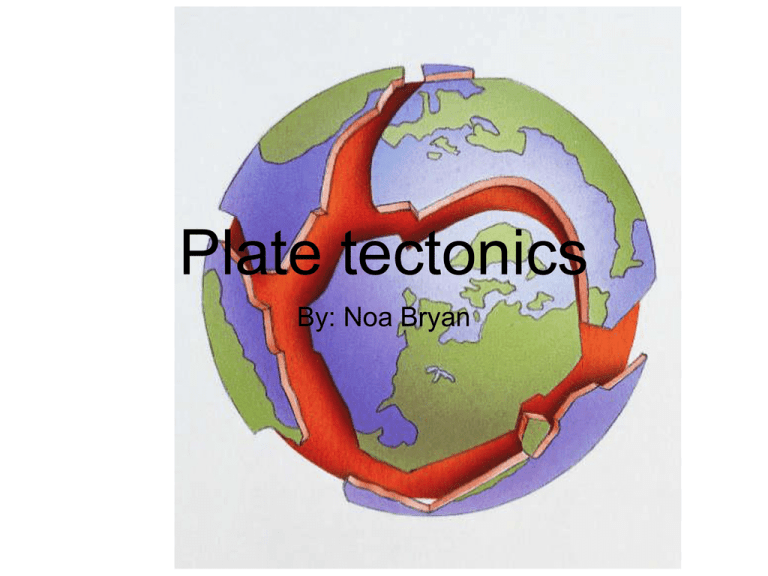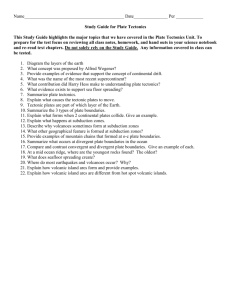plate techtonics - Mid
advertisement

Plate tectonics By: Noa Bryan Intro • Coming from the Latin word, tectonicus, plate tectonics essentially deals with the large scale motions of earths lithosphere • The theory builds on older concepts like continental drift for example Earths Plates • The Earth currently, has 7-8 major plates that make up the surface • These are the North American plate, Caribbean plate, South American plate, Antarctic plate, Pacific plate, Australian plate, Eurasian plate and the Nazca Plates Moving • The plates move in relation to one another under one of three boundaries being: • Convergent or collisional boundaries, divergent boundaries, also known as spreading centers, and conservative boundaries Composition • Tectonic plates are composed of two different types of lithosphere • One being a thicker continental crust • With the other being a thinner, oceanic one Subduction • When discussing earths crust and its movement, subduction is a key term • This is the sideways/downward movement of the edge of earths crust, into the mantle beneath another plate Sea-floor Spreading • Subduction is a sort of balance with the oceanic crust • Oceanic crust is formed along divergent margins due to sea floor spreading, also refereed to as the “conveyer belt” theory Plate examples • Conservative transformation of boundaries tend to grind past each other, and transform different faults. The San Andreas Fault in California is a perfect example of divergent boundaries Divergent • Divergent boundaries tend to be more constructive in nature • This occurs when two plates slide apart from each other, an example would be a mid ocean ridge i.e. the Mid Atlantic Ridge Convergent • Convergent boundaries tend to be more destructive in nature, and occur when plates slide towards each other, forming a subduction zone, or a continental collision • A prime example of this would be the Japanese island arc, or the Andes mountain range Plates in the Past • Our world today would appear very different that what it looked like billions of years ago • Earth was once a super continent, by the name of Colombia, which formed about 2 billion years ago, after breaking up, Rodinia was formed, embodying most of the worlds continents Cont. • After Rodinia broke up, the world separated into 8 different continents about 600 million years ago, these continents later reassembled into Pangaea, making all continents one super continent, which eventually broke up, due to plate tectonics and we have the world we know today! Works Cited • • • • "Earth Floor: Plate Tectonics." COTF. Web. 19 Apr. 2011. <http://www.cotf.edu/ete/modules/msese/earthsysflr/plates1.html> "Plate Tectonics World Ocean Floors." Plate Tectonics. Web. 19 Apr. 2011. <http://www.platetectonics.com/oceanfloors/index.asp>. "This Dynamic Earth--Contents [USGS]." USGS Publications Warehouse. Web. 19 Apr. 2011. <http://pubs.usgs.gov/gip/dynamic/dynamic.html>. "Tectonic Plates." Moorland Boarding School and Independent School Lancashire UK. Web. 19 Apr. 2011. <http://www.moorlandschool.co.uk/earth/tectonic.htm> Video • http://www.youtube.com/watch?v=GYV S_Yh6dTk








